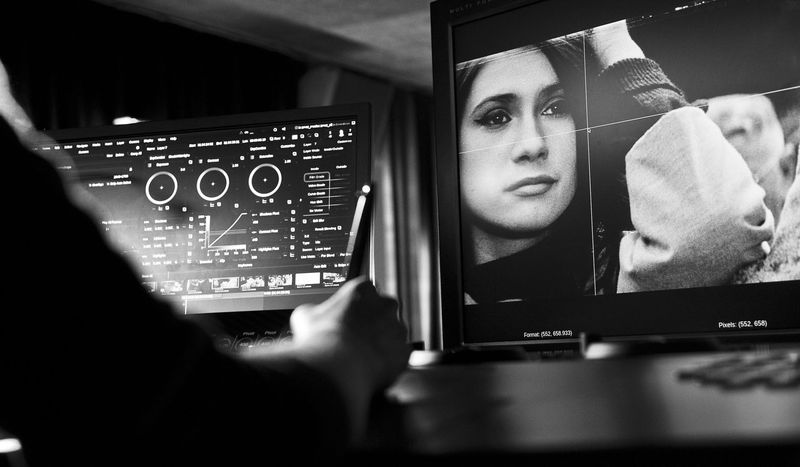Začiatok stránky, titulka:
Pokračovanie obsahu:
Digitisation Is Not Over, We Are Going Still Further
The national Digital Audiovision project, aimed at the digitisation of the Slovak audiovisual heritage, ended on 30 November 2015. However, that does not mean the end of digitisation because the archives of the Slovak Film Institute (SFI) and its partner in this project, the Radio and Television of Slovakia (RTVS), contain many works that both institutions will carry on digitising.

The project will be retained until 2020. “The SFI has undertaken to digitise at least a further fifty items in each subsequent year. This entails feature, animated, documentary films and newsreels,” said Peter Dubecký, the General Director of the Slovak Film Institute. “We anticipate that, within the retention period, 7,200 audio and 950 video items will be digitised every year,” added Andrej Doležal, the Director of the Technical Implementation Section of the RTVS.
Within the project, by 30 November 2015 the SFI had digitised 1,001 cultural items, 600 of which are newsreels, 198 animated, 158 documentary and 45 feature films. All in all, this represents 900 kilometers of film material. The screening of a restored and digitised film is an important event for the filmmakers. Thanks to the Digital Audiovision project it will be possible to screen their works in a high-quality form in digitised cinemas in Slovakia and abroad.
However, it requires a great deal of time, work and the cooperation of several experts to achieve the digital form of a work. For instance, the digitisation of Forget Mozart (Zabudnite na Mozarta, dir. Miloslav Luther) in the SFI’s newly built digitisation workplace in the basement of Cinema Lumière took a full eight months from the preparatory works through the digitisation and restoration of the image and soundtracks up to the production of the DCP digital cinema master and the master for long-term archiving. In all, 136,025 frames were digitised in the film and 46 expert staff – scanning, retouching experts, editors, a colourist, a sound-master, film archivists and other experts – took part in the entire process in a three-shift operation.
Films come to the SFI digitisation workplace after the laboratory process from the systematic restoration and rescue project which has been ongoing since 2004. Only after thorough diagnostics of the image and soundtracks do the experts start the retouching operation. And how do experts proceed in the restoration of films with regard also to the fact that the works were made in various periods and on film materials of varying quality? “In this process it is very important to determine the reference film print for the verification projections; the quality of the digitised film and the output digital master in the image and sound tracks are assessed on the basis of this copy... If the film is characterised by a specific granularity, we try to maintain it. If the image is characterised by a certain colour or tone, again we try to maintain it. If the sound has its characteristic expression, we also maintain it. Just as every director of photography had his own signature, so the signature of a sound-master is also discernible and can help us a lot when searching for the common features and dissimilarities of the individual films,” explains Peter Csordás, a digitisation expert and quality and control manager of the Digital Audiovision project. And he immediately adds that, when working with these films, consultations with the filmmakers themselves are important to assess what the auteur intention of the filmmakers was and what was caused, for instance, by imperfections in the recording material. “In particular, for this assessment we have guarantors of the laboratory process, guarantors for the image and guarantors for the sound. They are either the filmmakers who made these films or directors of photography suggested by the Association of Slovak Cinematographers. They remember the original atmospheres very well. They know what type of material they shot on, what turned out well and what not so well in the laboratories, what types of lighting fixtures and lighting they used...” It is essential that every digitised and restored film should conform to the appearance it had at the time it was made.
The RTVS, as a partner in the project, digitised 60,649 items at its digitisation workplace up to 30 November 2015. Up to 51,799 of them are audio items with authentic folklore and folk music programmes on analogue media, literary programmes of all genres on magnetic media, historic sound documents and items from the music fund. The remaining 8,850 items were video items, specifically journalistic and documentary works, and dramatic programmes.
The biggest digitisation project in the area of audiovision in Slovakia was supported from the European Union structural funds. The SFI carried out this project with its partner RTVS from 2011. In October 2015, the original amount of the grant, EUR 24,089,940.37 was adjusted to EUR 20,883,676.22, i.e. EUR 13,221,891.76 for the SFI and EUR 7,661,784.46 for the RTVS. Altogether, 77 staff members worked on the project in the SFI and 52 in the RTVS.
Simona Nôtová
PHOTO: SFI/Miro Nôta